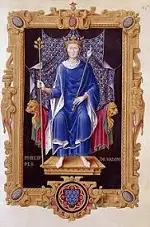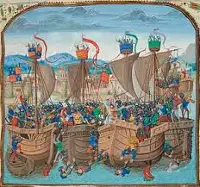The Hundred Years War
Part 1: The Early Years


Philip was the cousin of the previous French king, Charles IV. That king had died in 1328 without a male heir, and French law prohibited a king's ascension through a female heir. When Charles died, England's King Edward III (left) had made his own claim to the throne because he was the son of Isabella of France, Charles's sister, and, more importantly, the daughter of King Philip IV. France, citing its succession law, chose Philip VI (right) instead. Edward's claim was a nominal one, and the English didn't pursue the claim once the coronation of Philip VI was announced; however, the English didn't forget, either. 
Also during this period of royal instability, the on-again-off-again alliance between France and Scotland, known as the Auld Alliance, was on again. Charles IV had renewed the 1295 mutual aid treaty between the two countries in 1326. Philip VI assembled a fleet in the English Channel in 1336; the fleet had been planned as part of a new Crusade, but those plans didn't materialize. Still, there the fleet was, and England was faced with the possibility of wars in the north and the south. 
The French invasion of Gascony in 1337 triggered the war between England and France. Edward set about securing allies, notably Louis the Bavarian, gaining much-needed money and supplies and a base from which to invade France from the northeast. English forces won the naval Battle of Sluys in 1340, with Edward personally commanding a ship and ramming enemy ships with his own, and gained control of the English Channel. Edward officially declared himself King of France in that year as well. Next page > The War is On > Page 1, 2, 3, 4, 5, 6, 7
|
|
Social Studies for Kids
copyright 2002–2025
David White



 The Hundred Years War was a very long series of conflicts between England and France in the 14th and 15th Centuries, ostensibly over who ruled France. The war, which actually lasted 116 years, had its roots in the
The Hundred Years War was a very long series of conflicts between England and France in the 14th and 15th Centuries, ostensibly over who ruled France. The war, which actually lasted 116 years, had its roots in the 
